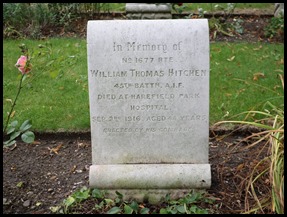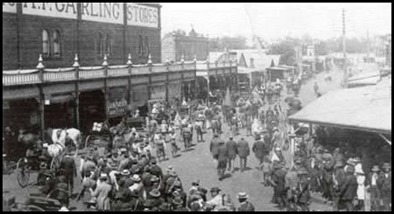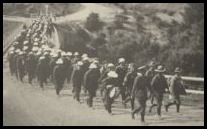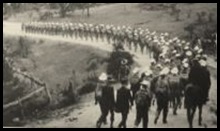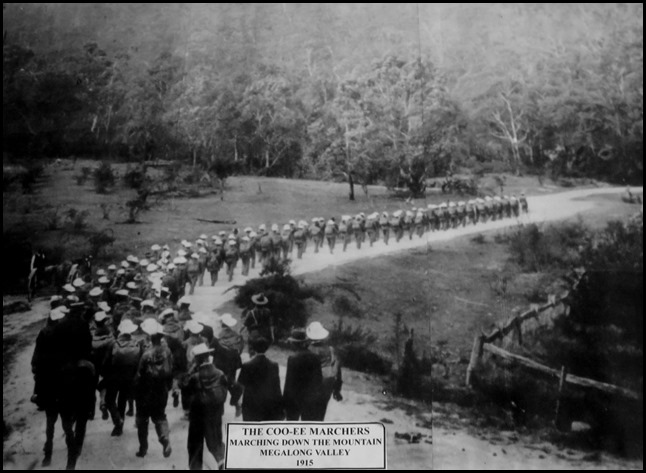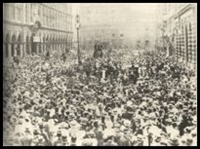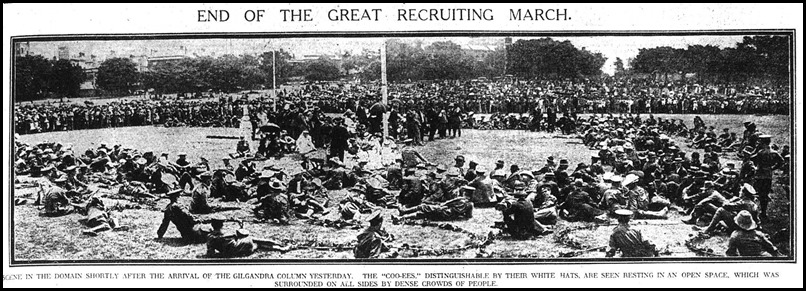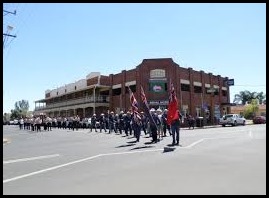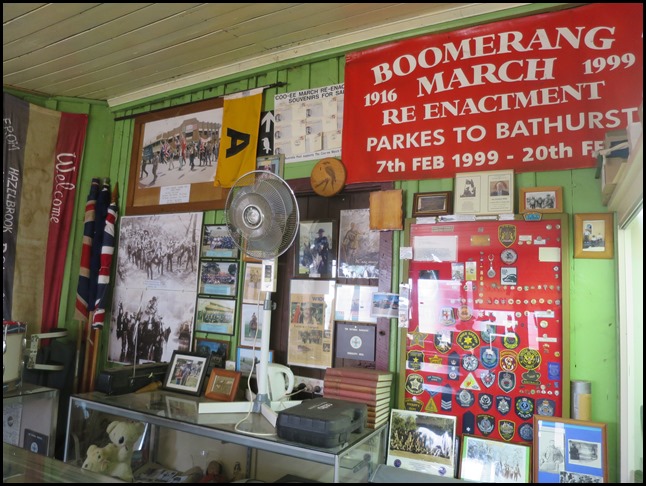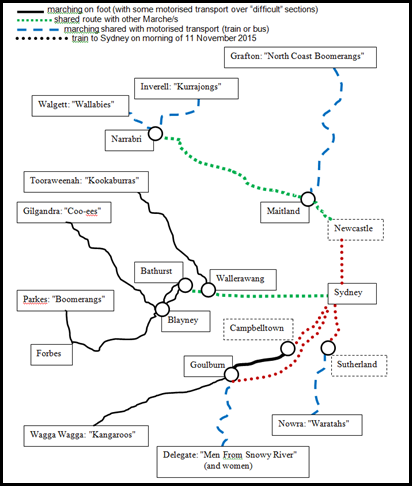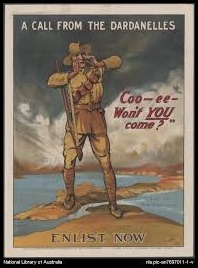Coo-ee

The start of the
Coo-ee March, Gilgandra.
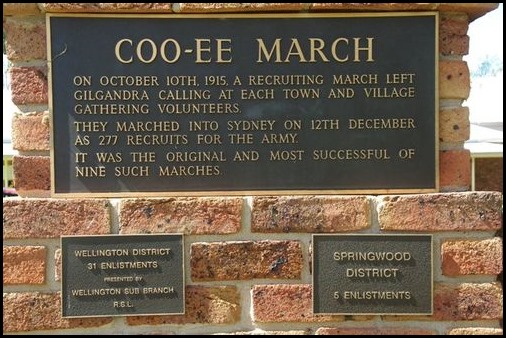 During World War
I, recruitment marches or snowball marches to Sydney were a feature of
volunteer recruiting drives for the Australian
Imperial Force in rural New South
Wales. Between October
1915 and February 1916, nine marches were held starting from various points in
the state; the most notable was the first march from Gilgandra, known as the
Coo-ee march. There was also a similar march in south-eastern Queensland. In
1918, in an effort to promote recruitment, another march was staged, but this
was less spontaneous and the marchers in fact travelled by
train.
The marches were called "snowball marches" in the hope that like a snowball rolling down a hill will pick up more snow, gaining more mass and surface area, and pick up even more snow as it rolls along, the marchers would also collect more marchers as they progressed to the recruiting depot.
William Thomas Hitchen, born in Mudgee was a married plumber and the captain of the local Gilgandra, New South Wales. He is credited with organising the first recruiting march, called the Coo-ee March, from Gilgandra to Sydney in late 1915. The march was an enormous success, together with his brother R G Hitchen, as well as organising the first march, he also assisted in organising the Kookaburra March. He enlisted in October 1915 but attestation forms were only signed at Bathurst in February 1916. W.T. Hitchen’s AIF number was 1677, his unit was the 45th Infantry Battalion, which was in the 12th Brigade, of the 4th Division. He declared his age at attestation as being forty four. However at this death less than a year later his age was given as fifty two. Private William Thomas Hitchen died of melanotic sarcoma (he was also ill with diabetes) on the 3rd of September 1916 and is buried in the cemetery of St Mary’s Church, Harefield, in Middlesex, England. There is a lovely certificate on the CWGC site. William Thomas's son, William James joined the AIF in July 1915, at just over nineteen years old and his occupation at enlistment was plumber. 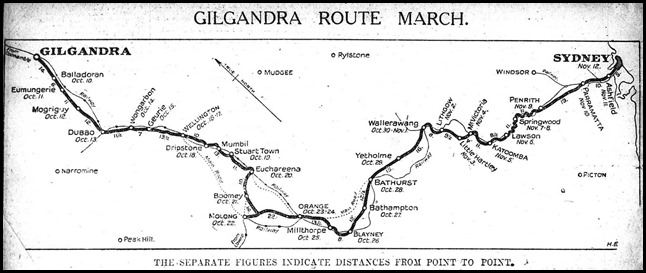 The Route. The following information
and photographs are extracted from John Meredith's book The Coo-ee March, 1986,
and can be purchased from the Gilgandra Coo-ee Heritage and Visitor Information
Centre.
Following the disaster of Gallipoli and the heavy casualties in France in the latter half of 1915, recruiting figures for enlistment in World War I had dwindled. Numerous recruiting rallies became increasingly ineffective. It was at this dark hour that Gilgandra's butcher, R.G. Hitchen and his brother Bill, the local plumber, had the idea of organising a route march of volunteers to Sydney, enlisting recruits as they marched. The idea caught the imagination of the public, and the Coo-ees (as the volunteers were known) became national heroes. The action of "Hitchen's Own" and the subsequent marches, which followed, were responsible for a dramatic upturn in recruitment figures.
Miller Street, Gilgandra. Leaving Wongardon.
Marching past Orange Post Office. Posing before they left Orange.
Letts River. Little Hartley. Hassan’s Wall, outside Lithgow.
Arriving in Katoomba. 5th and 6th of November.
Nearing Springwood in the Blue Mountains. Springwood. Arriving in Martin Place, Sydney.
Twenty six men left Gilgandra, a western town on the Castlereagh River. They were feted at each town on the route, and the stirring story of their march has become part of the official war history of Australia. Recruitment meetings were held in each centre and their numbers increased by the time they reached Sydney. Conditions in the country in 1915 were vastly different from those today. Meredith describes: The unsealed roads were made of dirt, or perhaps, in a town, of crushed stone or blue metal. In dry weather traffic was coincidental with clouds of dust; when it rained the roads became ribbons of mud. Considered against this background a march of three hundred and twenty miles over those rough roads was a much greater undertaking than it would be under today’s conditions. The feats of cooking, transporting and servicing the food provided for the Coo-ees at each camp place, and even assembling of welcoming crowds were huge accomplishments. There was an immense crowd which stretched from Newtown to the Sydney Domain to welcome the Coo-ees at the end of their historic march.
The jubilant end of the coo-ee march.
Coo-ee Re-enactment March – 24th of October 1987 to the 14th of November 1987 A band of brave men revisited our past and followed the footsteps of the 1915 Coo-ee March from Gilgandra to Sydney. As with the original march three men organised this re-enactment, Brian Bywater, Kimlyn Templeton and Robert McLean, who were relying on the generosity of private citizens in towns and cities along the route. Gilgandra contributed 40% of those who left Gilgandra as marchers and supporters. Seventy two years after Gilgandra's sons first left for war, the community still remembers efforts of the marchers and they came out in force to support and farewell the re-enactment. Gilgandra re-enacted the events leading up to the official send off. Thursday night a provisions and farewell was hosted by Apex at the Royal Hotel with a barbeque and bush band and a warm welcome to all visitors. On Friday Australia Post launched Gilgandra's Permanent Pictorial Postmark depicting and commemorating the 1915 Coo-ee March. Friday evening Gilgandra Entertainers hosted the Grand Ball. This was a memorable evening - most attired in period costume were entertained with the songs and footage of soldiers boarding ships destined for Gallipoli. Saturday morning Quota ladies put on an Aussie Breakfast in Quota Park followed by a morning service and blessing from Bishop Goldsworthy at St. Ambrose Church. The Shire President delivered the farewell speech in Bridge Street and the march moved off at 10 a.m. They were led out of Gilgandra by two horsemen in Light Horse Regalia, seven ladies on horses, the flags, the Shire President and twenty four marchers with banners followed by our R.S.L. Club, Returned Servicemen, Clubs, Scouts, citizens, vintage cars and horse drawn vehicles. This procession was followed by thousands of Gilgandra residents to Coo-ee March Memorial Park for a memorial service and a twenty one gun salute by the Rifle Club at Boberah Bridge was re-enacted. This march continued on to Sydney via the route of the original march and received a rousing reception in Sydney some twenty two days later. Film Australia captured the story of these Coo-ees for all to see in a movie, which received nominations for the Sydney and Melbourne Film Festivals.
The Parkes to Bathurst re-enactment memorabilia in the Gilgandra Museum.
The Centenary March has been planned and so far a hundred and fifty have signed up for this incredible memorial to the original march.
Bear wishing Brian all the very best for next years, three week, centenary march.
ALL IN ALL JUST THE MOST AMAZING STORY INCREDIBLE
|



